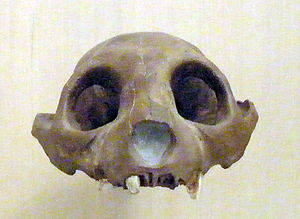Archaeolemurinae
| Archaeolemurinae | ||||||||||||
|---|---|---|---|---|---|---|---|---|---|---|---|---|

Skull of Archaeolemur majori in the American Museum of Natural History in New York |
||||||||||||
| Systematics | ||||||||||||
|
||||||||||||
| Scientific name | ||||||||||||
| Archaeolemurinae | ||||||||||||
| Forsyth Major , 1896 |
The Archaeolemurinae are an extinct group of primates that lived in Madagascar until around 1000 years ago . Today they are mostly classified as a subfamily of the Indri-like (Indriidae), earlier they were considered a separate family as Archaeolemuridae. They showed similarities with the baboons in their physique and probably also in their way of life .
These primates probably reached a weight of 15 to 25 kilograms. Their skull structure is similar to that of the living Indri-like, but was more massive and had, among other things, a stronger lower jaw. The upper incisors were greatly enlarged and protruded just as much as the lower incisors, the three premolars were enlarged and formed a continuous shear edge. The molars only had small, rounded cusps.
The limbs of these animals were short and strong, their anatomy indicates - in convergent development to some vervet monkey relatives - a predominantly ground-dwelling way of life.
Subfossil remains between 3,000 and 1,000 years old have been found in several parts of Madagascar. Their extinction is likely to be directly related to the settlement of this island 1500 years ago. In the course of this settlement, a number of large animals, including primate species such as the giant lemur , were exterminated, presumably due to hunting and the extensive destruction of the habitat through slash and burn.
There are two genera with three species.
- The genus Archaeolemur comprised two species, A. majori and A. edwardsi . It reached a weight of 15 to 25 kilograms and had short, strong limbs that developed in a manner similar to that of the baboons . The molars also show convergences to these animals, so that an omnivorous diet (fruits, seeds and small animals) can be assumed.
- The genus Hadropithecus included only one species, H. stenognathus . It was approximately the same size as Archaeolemur and resembled it in physique, but was even more adapted to a terrestrial way of life. Its skull structure and teeth show striking similarities with those of the Jelada . It is believed that, similar to this, he mainly fed on grasses, an extremely rare diet among primates.
literature
- Thomas Geissmann : Comparative Primatology. Springer-Verlag, Berlin et al. 2002, ISBN 3-540-43645-6 .
- Russell A. Mittermeier , Jörg U. Ganzhorn, William R. Konstant, Kenneth Glander, Ian Tattersall , Colin P. Groves , Anthony B. Rylands, Andreas Hapke, Jonah Ratsimbazafy, Mireya I. Mayor, Edward Louis jr, Yves Rumpler, Christoph Schwitzer, Rodin Rasoloarison: Lemur Diversity in Madagascar. In: International Journal of Primatology. 29, 2008, ISSN 0164-0291 , pp. 1607-1656.
- Ronald M. Nowak: Walker's Mammals of the World. 6th edition. Johns Hopkins University Press, Baltimore MD 1999, ISBN 0-8018-5789-9 .
